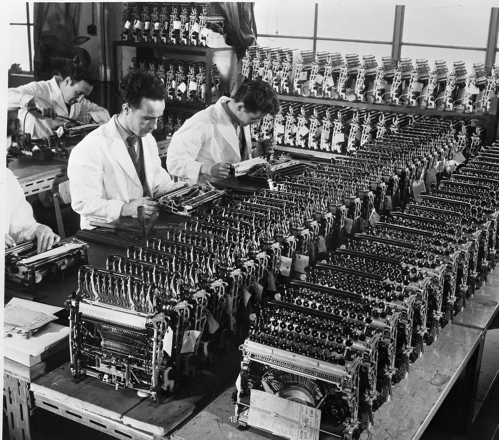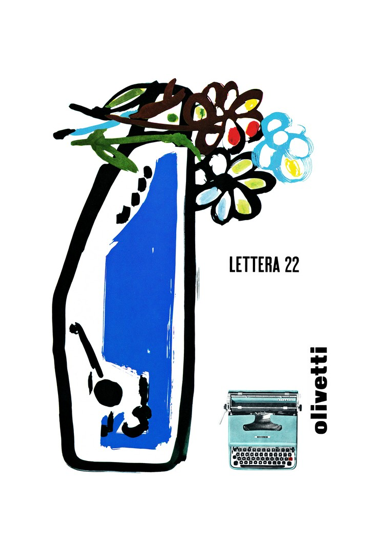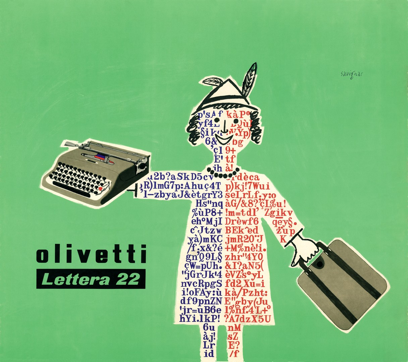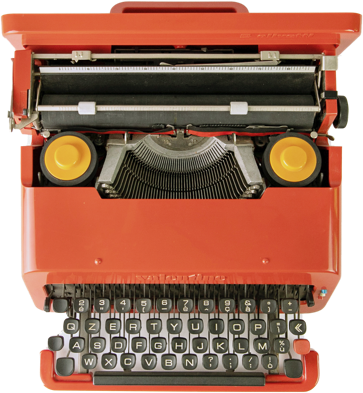

The Olivetti Company’s historical archive, which represents the quantitatively most important part of the documentary heritage preserved by the Olivetti Historical Archive Association, consists of millions of documents from different sources (corporate bodies, individuals) and a range of documentary types (manuscripts, minutes, correspondence, publications, projects, drawings, posters, photographs, audio, video, magazines, books).
Given that collection and conservation activities only began in 1984–85 (some 80 years after the founding of the company), part of the historical documentation has been irretrievably lost. However, the documentary heritage is still remarkable in quantitative and qualitative terms and represents an irreplaceable tool for investigating Olivetti’s history and the profound industrial and social transformations that have accompanied it.
From the first drawing of the factory in 1895 (not to mention some letters on printed writing from 1808) to the most recent documents and catalogue sheets, passing through many famous products such as the Lettera 22, the Divisumma 24, the Elea 9003, the Programma 101, the Personal Computer M24, etc., the documentation testifies to the story of an industry that has left a deep mark on the economy, technology and culture of our country for over a century.
To this heritage must be added the second important documentary resource provided by the Adriano Olivetti Foundation: these are the archives owned by the Foundation, namely those of Camillo, Adriano and the other members of the Olivetti Family, and other archives entrusted to the Foundation and preserved by the Olivetti Historical Archive Association concerning the archive of the architect Ludovico Quaroni and a portion of the archive of George Friedmann.
Other collections held by the Olivetti Historical Archive Association are the Trade Union Organisation archives (documents of the minutes of company agreements, leaflets, typescripts and studies from the workers’ organisations operating in the Olivetti plants) and Former Olivetti Employees (documents, notes, objects from Olivetti workers’ activities, often “saved” from loss and entrusted to the care of the Association).
Via Miniere, 31 – 10015 Ivrea (TO)
Open Monday to Friday
8.30 •12.30 / 13.30 • 17.00 by appointment

Archive sections
This is the richest part of the Olivetti Company Collection; consisting of millions of documents, the sub-collection is the subject of systematic electronic filing, which is long and complex but planned in such a way as to give priority to areas and documents of greatest interest.
The preserved documentation comes from a variety of sources (corporate bodies, individuals) and consists of diverse documents types (manuscripts, notes, reports, correspondence, projects, drawings, printed materials, etc.). Considering that the collection and conservation activity began only in 1986 (almost 80 years after the foundation of the company), part of the historical documentation has been irretrievably lost. Therefore, not all sectors or events in company life can be fully documented.
However, the remarkable quantity and quality of the documentary heritage represents an irreplaceable tool for investigating the complex history of Olivetti and the profound industrial and social transformations that have accompanied it.
The company documents bear witness to the changes that, with the transition from mechanics to electronics and then to information technology and telecommunications, have involved technology, production and strictly business activities alongside the social context and industrial culture.
These documents allow us to retrace many key moments in research activities, design, production, marketing and trade in Italy and abroad; but can also include industrial architecture, design and advertising, the life and work of many prominent industry figures,factory organisation, training of personnel, and thesocial and cultural commitment, inside and outside the factory, of a responsible company towards its employees, the local community and the territory.
The Photographic Library contains hundreds of thousands of images that shed light on the development of the company over a century and its involvement in the transformation of the territory, starting from the first historical photographs to the most recent industrial and cultural achievements.
The collection contains works by great photographers commissioned by Olivetti for specific photographic services to “narrate” important events, the opening of new offices and factories, the launch of new products or even to document life in the factory and the world of work: these include photographs by Berengo Gardin, Mulas, Ballo, Roiter, Cartier Bresson, Phillips, Scheidegger, Schulthess and many others.
Alongside the “photos d’auteur” of prominent figures, reportage, working environments, industrial products and buildings, there are also images of normal photographic documentation and even amateur photos taken by employees bearing witness to different moments in company life and beyond. The result is a wide range of themes and subjects that further qualifies the Photographic Library as an effective tool for documenting company history.
The approximately 3,000 films comprising the Film Library represent a uniquely interesting segment of industrial cinema, not so much for the antiquity of the films (the oldest date back to the 1940s), but for the quality of the texts and images and the variety of topics covered.
Alongside the technical and informational videos aimed at Instruction and Training or Product Documentation, other films are more oriented toward promotional communication: advertising, corporate image, event presentation or company achievements.
Of greater historical importance in offering truly original documentation of the time, with relevance beyond the company, are the films on Industrial buildings, Social Services and those in the section covering Community Movement, which describe the political, social and cultural experiment conducted in Ivrea and Canavese in the 1950s and 1960s.
The Film Library contains a highly original section relating to Art Films (including about twenty “critofilms” produced by the art critic and historian Carlo Ludovico Ragghianti) and films on restorations and exhibitions undertaken by Olivetti.
The Industrial Films, produced either directly by Olivetti or commissioned from talented external directors, constitute an important part in the history of Italian industrial cinema.
All the films of the Film Library are now kept at the Archivio Nazionale Cinema d’Impresa (National Archive of Industrial Film), established in Ivrea in 2005, which is able to provide optimal solutions for the proper conservation of delicate films. A number of works have also been carefully restored and digitalised.
You can watch a wide selection of Olivetti films on the YouTube channel of the National Archive of Industrial Cinema
Olivetti is renowned for the quality of its institutional and advertising graphics. From the very beginning, Olivetti has always considered the beauty of design and graphic-advertising communication not only from a purely aesthetic-formal aspect, but as a substantial aspect of its strategy and its company outlook. This approach is manifest in the collection of posters and advertising campaigns dedicated to individual products or to the general corporate image.
Despite the variety of authors and styles, these collections document a tradition of good taste, refined innovation and effective communication. The collection plots a course though the classic design of artists such as Teodoro Wolf Ferrari, Marcello Dudovich and Pirovano to graphic forms influenced by contemporary and rationalist art under the direction of Leonardo Sinisgalli, up to the exuberance, unique in style and imagination, expressed until the early 1960s by Giovanni Pintori. This is followed by numerous designers and graphic designers who, through their creativity, ability to synthesise, communicative effect and use of varied techniques, reinforce a long tradition of graphic and advertising excellence year after year.
The Advertising Library also includes the collections of images developed since 1951 as promotional material for the activities of the Olivetti Cultural Centre. Billboards, posters, cards, programmes and catalogues drawn up for exhibitions, conferences, conferences, popular courses, concerts, sightseeing and sports activities, but also to develop and communicate culture in the belief that a large industrial organisation, such as Olivetti, was not only a workplace, a centre for the production of goods, but could also express itself as an environment benefitting the social and cultural growth of society as a whole.
Some of the most significant historical posters (350) have been digitised thanks to the project promoted by the Piedmont Region and the Ministry of Cultural Heritage aimed at enhancing the archival and iconographic materials of Piedmontese companies.
The collection holds a huge variety of office machines produced by Olivetti and other manufacturers – typewriters, calculators, accountants, telewriters, computers, printers, cash counting machines, fax machines and computers – amounting to almost 1,000 pieces, including about 190 models of machines from global competitors.
The collection also contains a valuable promotional items made by famous designers, as well as prototypes of product bodywork.



Other collections held
Owned by the Adriano Olivetti Foundation, this archive contains documentation of particular importance relating to the prominent figures in Olivetti’s history: in particular, Camillo, Adriano and Roberto Olivetti. These documents, manuscripts, images, correspondence, writings, notes, projects and reports tell the human and commercial story of great figures engaged in weaving a significant network of relationships in a passionate attempt to develop all aspects of the company and the territory.
This archive consists of the library and a rich collection of documents relating to the activity of the architect Ludovico Quaroni. Owned by the heirs of Ludovico Quaroni, it is held at the Adriano Olivetti Foundation.
While relatively small, this is a significant collection as it relates to the study initiated by Adriano Olivetti and entrusted to the German-American sociologist for the construction of the La Martella village and the organic restoration of the Sassi di Matera area.



To access documentary material, please
submit an application by sending an email to
segreteria@archiviostoricolivetti.it, indicating:
• list of material to be consulted;
• reason for the request;
• a brief description of the project or work related to the request, if possible.
For your convenience, you can download the Consultation Request form and return it to us by email.
Due to the high number of requests, the average response time of our offices is about 10 working days.
Iscriviti alla newsletter
Stay up to date on the Olivetti world, subscribe to ours Newsletters!
Associazione Archivio Storico Olivetti
Via Miniere, 31 • 10015 Ivrea (TO)
+ 39 0125 641238 • segreteria@archiviostoricolivetti.it
PEC: archiviostoricolivetti@pec.it
© Associazione Archivio Storico Olivetti – P. IVA 07557530016 • CF 93023540011
Design Cappelli Identity Design
Archive Timetable
from Mon. to Fri.
8.30 a.m. – 12.30 p.m. • 1.30 p.m. – 5.00 p.m.
by appointment
Library Timetable
from Mon. to Fri.
8.30 a.m. – 12.30 • 1.30 p.m. – 5.00 p.m.
free entry and consultation